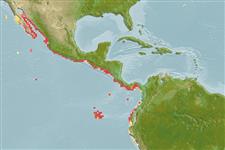Environment: milieu / climate zone / depth range / distribution range
Ecología
marino asociado a arrecife; rango de profundidad 0 - 18 m (Ref. 5227). Tropical; 30°N - 10°S, 120°W - 70°W
Eastern Pacific: Bahía Sebastían Vizcaino and the northern Gulf of California (Isla Angel de la Guarda and Puerto Lobos) to Peru, including the Galapagos Islands (Ref. 5590).
Tamaño / Peso / Age
Maturity: Lm ? range ? - ? cm
Max length : 18.0 cm SL macho / no sexado; (Ref. 28023); common length : 12.0 cm TL macho / no sexado; (Ref. 55763)
Short description
Morfología | Morfometría
Body cylindrical; head with cirri above the eyes, on the nape, and at the posterior edge of the anterior nostril; maxillary not protrusible; each jaw with one row of incisiform teeth; anal and dorsal fins elongated ; lateral line divided into two, independent, overlapping segments (Ref. 55763).
Adults prefer the surge zone of unprotected rocky headlands with steep slopes. They wedge themselves in crevices close to shore in shallow water, darting out to defend their territory. Diurnal feeders that graze on algae and sessile invertebrates, using their comb-like incisor teeth to scrape food (Ref. 28023). Oviparous. Eggs are demersal and adhesive (Ref. 205), and are attached to the substrate via a filamentous, adhesive pad or pedestal (Ref. 94114). Larvae are planktonic, often found in shallow, coastal waters (Ref. 94114).
Life cycle and mating behavior
Madurez | Reproducción | Puesta | Huevos | Fecundidad | Larva
Oviparous, distinct pairing (Ref. 205).
Thomson, D.A., 1987. Reef fishes of the Sea of Cortez. The rocky-shore fishes of the Gulf of California. The University of Arizona Press, Tucson. 302 p. (Ref. 5592)
IUCN Red List Status (Ref. 130435)
Threat to humans
Harmless
Human uses
Pesquerías: sin interés; Acuario: Comercial
Más información
ReferenciasAcuiculturaPerfil de acuiculturaRazasGenéticaElectrophoresesheritabilidadEnfermedadesProcesamientoNutrientsMass conversion
ColaboradoresImágenesStamps, Coins Misc.SonidosCiguateraVelocidadTipo de nataciónSuperficie branquialOtolitosCerebrosVisión
Herramientas
Special reports
Download XML
Fuentes de Internet
Estimates based on models
Preferred temperature (Ref.
123201): 20.3 - 29.1, mean 26.1 °C (based on 200 cells).
Phylogenetic diversity index (Ref.
82804): PD
50 = 0.5312 [Uniqueness, from 0.5 = low to 2.0 = high].
Bayesian length-weight: a=0.00955 (0.00505 - 0.01805), b=2.99 (2.83 - 3.15), in cm total length, based on LWR estimates for this species & (Sub)family-body (Ref.
93245).
Nivel trófico (Ref.
69278): 2.7 ±0.25 se; based on food items.
Resiliencia (Ref.
120179): Medio, población duplicada en un tiempo mínimo de 1.4-4.4 años (Assuming tm=1 and Fec 100-1000).
Fishing Vulnerability (Ref.
59153): Low vulnerability (12 of 100).
Nutrients (Ref.
124155): Calcium = 82.9 [47.2, 125.0] mg/100g; Iron = 0.688 [0.441, 1.054] mg/100g; Protein = 18.7 [17.6, 19.6] %; Omega3 = 0.129 [0.087, 0.193] g/100g; Selenium = 22.1 [13.5, 38.2] μg/100g; VitaminA = 120 [41, 341] μg/100g; Zinc = 1.82 [1.31, 2.45] mg/100g (wet weight);
